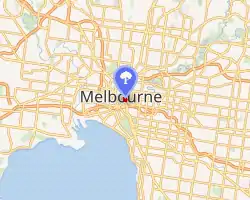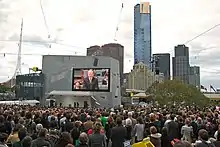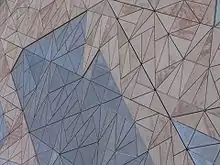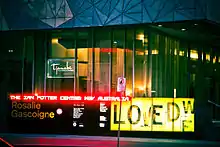Federation Square
Federation Square (colloquially Fed Square) is a venue for arts, culture and public events on the edge of the Melbourne central business district. It covers an area of 3.2 ha (7.9 acres) at the intersection of Flinders and Swanston Streets built above busy railway lines and across the road from Flinders Street station. It incorporates major cultural institutions such as the Ian Potter Centre, Australian Centre for the Moving Image (ACMI) and the Koorie Heritage Trust as well as cafes and bars in a series of buildings centred around a large paved square, and a glass walled atrium.
| Federation Square | |
|---|---|
.jpg.webp) | |
 | |
| Type | Public space |
| Location | Melbourne, Australia |
| Coordinates | 37.817798°S 144.968714°E |
| Area | 3.2 ha (7.9 acres) |
| Created | 26 October 2002 |
| Designer | Lab Architecture Studio Bates Smart |
| Operated by | Fed Square Pty Ltd (State Trustees Ltd for State of Victoria) |
| Visitors | 9.7 million per annum |
| Open | All year |
| Public transit access | Flinders Street station |
History
Background
Melbourne's central city grid was originally designed without a central public square, long seen as a missing element. From the 1920s, there had been proposals to roof the railway yards on the south-east corner of Flinders and Swanston Streets for a public square, with more detailed proposals prepared in the 1950s and 1960s.[1] In the 1960s, the Melbourne City Council decided that the best place for the City Square was the corner of Swanston and Collins Streets, opposite the town hall. The first temporary square opened there in 1968, and a permanent version opened in 1981. It was, however, not considered a great success, and was redeveloped in the 1990s as a smaller, simpler space in front of a new large hotel.
Meanwhile, in the late 1960s, a small part of the railway yards, occupied by Princes Bridge railway station, had been partly roofed by the construction of the Princes Gate Towers, which became known as the Gas & Fuel Buildings after their major tenant, the Gas and Fuel Corporation. The project included a plaza on the corner, which was elevated above the street and little used. Between the plaza and Batman Avenue, which ran along the north bank of the Yarra River, were the extensive Jolimont Railway Yards, and the through train lines running into Flinders Street station under Swanston Street.[2]
Design competition and controversy
In 1996 the Premier Jeff Kennett announced that the Gas & Fuel Buildings would be demolished, and the railyards roofed, and a complex including arts facilities and a large public space would be built. It was to be named Federation Square, and opened in time to celebrate the centenary of Australia's Federation in 2001, and would include performing arts facilities, a gallery, a cinemedia centre, the public space, a glazed wintergarden, and ancillary cafe and retail spaces. An architectural design competition was announced that received 177 entries from around the world.[3] Five designs were shortlisted, which included entries from high-profile Melbourne architects Denton Corker Marshall and Ashton Raggatt McDougall, and lesser known Sydney architect Chris Elliott, and London based Jenny Lowe/Adrian Hawker. The winner announced in July 1997,[4] was a consortium of Lab Architecture Studio directed by Donald Bates and Peter Davidson from London, with the Dutch firm Karres en Brands Landscape Architects, directed by Sylvia Karres and Bart Brands, who joined with local architects Bates Smart for the second stage.[5]
The design, originally costed at between $110 and $128 million, was complex and irregular, with gently angled 'cranked' geometries predominating in both the planning and the facade treatment of the various buildings and the wintergardens that surrounded and defined the open spaces. A series of 'shards' provided vertical accents, while interconnected laneways and stairways and the wintergarden would connect Flinders Street to the Yarra River. The open square was arranged as a gently sloping amphitheatre, focussed on a large viewing screen for public events, with a secondary sloped plaza area on the main corner. The design was widely supported by the design community but was less popular with the public. The design was also soon criticized when it was realised that the western freestanding 'shard' would block views of the south front of St Paul's Cathedral from Princes Bridge.[1]
The mix of occupants and tenants were soon modified, with the cinemedia centre becoming the new body known as ACMI, offices for multicultural broadcaster SBS added, and the gallery space becoming the Australian art wing of the National Gallery of Victoria, which became the Ian Potter Centre. The performance arts space was dropped, the number of commercial tenancies increased, and the south end of the Atrium became an auditorium. A new substantially rearranged design incorporating the new program was revealed in late 1998.[6]
Construction
After the 1999 State election, while construction was well underway, the incoming Bracks Government ordered a report by the University of Melbourne's Professor Evan Walker into the 'western shard' to be located on the corner of Flinders and Swanston Streets, which concluded in February 2000 that the "heritage vista" towards St Paul's cathedral should be preserved, and the shard be no more than 8m in height.[7]
Budgets on the project blew out significantly due to the initial cost being seriously underestimated, given the expense of covering the railyards, changes to the brief, the need to resolve construction methods for the angular design, and the long delays.[8][9] Among measures taken to cut costs was concreting areas originally designed for paving.
The final cost of construction was approximately $467 million (over four times the original estimate), the main funding primarily from the state government, with $64 million from the City of Melbourne, some from the federal government, while private operators and sponsors paid for fitouts or naming rights.[10]
The square was opened on 26 October 2002.[11] Unlike many Australian landmarks, it was not opened by the reigning monarch, Elizabeth II, nor was she invited to its unveiling; she visited Federation Square in October 2011.[12]
Further expansion
In 2006, Federation Wharf redeveloped the vaults under Princes Walk (a former roadway) into a large bar, with extensive outdoor areas on the Yarra riverbank, with elevator access to Federation Square.
Several proposals have been prepared for the area known as Federation Square East, the remaining area of railyards to the east. There have been proposals for office towers and, more recently, a combination of open space and a hotel, or another campus for the National Gallery of Victoria to house their contemporary art collection.[13]
Apple Store
In December 2017, the Andrews government announced that one of the buildings of the square, the Yarra Building, would be demolished to make way for a freestanding Apple Store, generating strong criticism over the commercial use of a cultural space.[14] Opposition groups including Our City Our Square and the National Trust of Australia (Victoria) then nominated Fed Square to the Victorian Heritage Register, which resulted in an interim decision to list in October 2018.[15] Apple cancelled the plans in April 2019 after the application to Heritage Victoria to demolish the Yarra Building was denied,[16] and after a hearing, the square was formally listed in August 2019.[17]
Metro Entrance
With the construction of the upcoming Melbourne Metro Tunnel, an entrance to the underground Town Hall station from the corner of Federation Square was proposed, with a design released in December 2018 that would replace the corner Information Centre.[18] After the heritage listing of the square, a permit was sought to demolish the building and the plaza around it, which was granted on the basis that the Information Centre was not the original design for the 'Western Shard', and it was demolished by January 2019,[19] though without a final approved design for the new entrance.
Melbourne Arts Precinct Transformation
In 2022, Fed Square became part of the Melbourne Arts Precinct Corporation (MAP Co),[20] which is also responsible for delivering the $1.7 billion Melbourne Arts Precinct Transformation - Australia’s largest ever cultural infrastructure project.
The inaugural CEO of MAP Co is Katrina Sedgwick, the former CEO of ACMI.[21] Fed Square will be an integral part of the Melbourne Arts Precinct, which will span both sides of the Yarra River.
Location and layout
Federation Square occupies roughly a whole urban block bounded by Swanston, Flinders, and Russell Streets and the Yarra River. The open public square is directly opposite Flinders Street station and St Paul's Cathedral. The layout of the precinct is designed to connect the historical central district of the city with the Yarra River and a new park Birrarung Marr.


Design features
Square

The complex of buildings forms a rough U-shape around the main open-air square, oriented to the west. The eastern end of the square is formed by the glazed walls of The Atrium. While bluestone is used for the majority of the paving in the Atrium and St Paul's Court, matching footpaths elsewhere in central Melbourne, the main square is paved in 470,000 ochre-coloured sandstone blocks from Western Australia[11] and invokes images of the outback. The paving is designed as a huge urban artwork, called Nearamnew, by Paul Carter and gently rises above street level, containing a number of textual pieces inlaid in its undulating surface.
There are a small number of landscaped sections in the square and plaza which are planted with Eucalyptus trees.
Plaza and giant screen

A key part of the plaza design is its large and fixed public television screen, which has been used to broadcast major sporting events such as the AFL Grand Final and the Australian Open every year. It is currently the biggest broadcasting screen in Australia.[22]
Buildings

The architecture of the square is in the deconstructivist style, with both plan and elevations designed around slightly angular, 'cranked' geometries, rather than tradition orthogonal grids. The built forms are mainly slightly bent north–south volumes, separated by glazed gaps, a reference to traditional Melbourne laneways, with vertical 'shards', attached or freestanding, containing discrete functions like the Visitor's Centre, or lifts and stairs.
The larger built volumes are relatively simple reinforced concrete buildings with glass walls, but with a second outer skin of cladding carried on heavy steel framing, folded and stepped slightly to create angular undulating surfaces. The cladding is composed of 6 different materials, zinc, perforated zinc, glass, frosted glass, sandstone and no cladding, in a camouflage-like pattern, and created using pinwheel tiling. The 'crossbar' is an east–west built from that runs through the long gallery building, and is clad in perforated black steel panels.
Some buildings are named. The building along Flinders Street that houses ACMI and SBS is named the Alfred Deakin Building, the building between the plaza space and the river is called the Yarra Building, while the building that houses the NGV Australia is also called the Ian Potter Centre.
Shards

Three shards frame the square space. The eastern and southern shards are completely clad in metallic surfaces with angular slots, very similar in design to the Jewish Museum Berlin, while the western shard is clad in glass. Adjoined to the southern shard is a hotel which features the wrap around metallic screen and glass louvers.
Laneways
There are a number of unnamed laneways in the Federation Square complex which connect it to both Flinders Street and the Yarra River via stairways. The stairways between the Western Shard and nearby buildings are also paved in larger flat rectangle sandstone blocks.
Riverfront
The riverfront areas extend south to an elevated pedestrian promenade which was once part of Batman Avenue and is lined with tall established trees of both deciduous exotic species and Australian eucalypts. More recently, the vaults adjacent to the Princes Bridge have been converted into Federation Wharf, a series of cafes and boat berths. Some of the areas between the stairs and lanes leading to the river are landscaped with shady tree ferns.
Atrium

The "atrium" is one of the major public spaces in the precinct. It is a laneway-like space, five stories high with glazed walls and roof. The exposed metal structure and glazing patterns follow the pinwheel tiling pattern used elsewhere in the precinct's building facades.[23]
Labyrinth
The "labyrinth" is a passive cooling system sandwiched above the railway lines and below the middle of the square. The concrete structure consists of 1.2 km of interlocking, honeycombed walls. It covers 1600 m2. The walls have a corrugated profile to maximize their surface area, and are spaced 60 cm apart.
During summer nights, cold air is pumped in the combed space, cooling down the concrete, while heat absorbed during the day is pumped out. The following day, cold air is pumped from the labyrinth out into the atrium through floor vents. This process can keep the atrium up to 12 °C cooler than outside. This is comparable to conventional air conditioning, but using one-tenth the energy and producing one-tenth the carbon dioxide.
During winter, the process is reversed, storing warm daytime air in the Labyrinth overnight, and pumping it back into the atrium during the day.
The system can also partly cool the ACMI building when the power is not required by the atrium.
Flagpoles
In the Federation Square complex, there are a number of flagpoles, most notably a set of eight in front of the Flinders Street Station. On most occasions they fly the Australian flags and custom made flags for promoting Federation Square, however, due to Australia's multiculturalism, many foreign countries' flags are raised on these flagpoles to celebrate a national holiday of that country, e.g. independence.
Facilities and tenants
In addition to a number of shops, bars, cafés and restaurants, Federation Square's cultural facilities include:
Melbourne Visitor Centre

The Melbourne Visitor Centre is located underground, with its entrance at the main corner shard directly opposite Flinders Street Station and St Pauls Cathedral and its exit at the opposite shard. The entrance and exit shards feature interactive news tickers in colour LEDs and small screens promoting current activities. The Visitor Centre was intended to replace a facility which was previously located at the turn of the 19th-century town hall administration buildings on Swanston Street. The Visitors Centre was demolished in December 2018 to make way for an entrance to the Melbourne metro station to be built under the Swanston Street, and the visitors centre returned to the Town Hall.
The Edge

The Edge theatre is a 450-seat space designed to have views of the Yarra River and across to the spire of The Arts Centre. The theatre is lined in wood veneer in similar geometrical patterns to other interiors in the complex. The Edge was named "The BMW Edge" until May 2013, when a new sponsorship deal with Deakin University caused it to be renamed "The Deakin Edge".
Zinc
Zinc is a function space underneath the gallery building, and opens onto the Yarra river bank. It was intended as an entirely commercial part of the development of Federation Square, and is used for wedding receptions, corporate events, launches, and the like.[24]
National Gallery of Victoria

The Ian Potter Centre, also known as the NGVA, houses the Australian part of the art collection of the National Gallery of Victoria (NGV), in the building along the eastern side. (The St Kilda Rd building now houses that International works of the NGV, and is known as the NGVI). There are over 20,000 Australian artworks, including paintings, sculpture, photography, fashion and textiles, and the collection is the oldest and most well known in the country.
Well-known works at the Ian Potter Centre include Frederick McCubbin's Pioneers (1904) and Tom Roberts' Shearing the Rams (1890). Also featured are works from Sidney Nolan, John Perceval, Margaret Preston and Fred Williams. Indigenous art includes works by William Barak and Emily Kngwarreye.
The National Gallery at Federation Square also features the NGV Kids Corner, which is an interactive education section aimed at small children and families, and the NGV Studio.
ACMI (Australian Centre for the Moving Image)

The Australian Centre for the Moving Image known as ACMI has two cinemas that are equipped to play every film, video and digital video format, with attention to high-quality acoustics. The screen gallery, built along the entire length of what was previously a train station platform, is a subterranean gallery for experimentation with the moving image. Video art, installations, interactives, sound art and net art are all regularly exhibited in this space. Additional venues within ACMI allow computer-based public education, and other interactive presentations.
In 2003, ACMI commissioned SelectParks to produce an interactive game-based, site-specific installation called AcmiPark, which replicated and abstracted the real-world architecture of Federation Square. It also houses highly innovative mechanisms for interactive, multi-player sound and musical composition.
Transport Hotel Bar
Transport hotel and bar is a three-level hotel complex adjacent to the southern shard on the south western corner of the square. It has a ground-floor public bar, restaurant and cocktail lounge on the rooftop.
SBS Radio and Television offices
.jpg.webp)
The Melbourne offices of the Special Broadcasting Service (SBS), one of Australia's two publicly funded national broadcasters, is in the Deakin Building on Flinders Street.
Melbourne Festival headquarters
The headquarters of Melbourne Festival (formerly Melbourne International Arts Festival) are located on Level 2 of the Yarra Building.
Beer awards
Federation Square has recently become home to several beer award shows, and tastings, including the Australian International Beer Awards trade and public shows, as well as other similar events such as showcases of local and other Australian breweries. These events have been held in the square's outdoor area the Atrium and usually require an entry fee in exchange for a set number of tastings.
Past tenants
Past tenants have included:
- "Champions" – The Australian Racing Museum & Hall of Fame - Relocated to Melbourne Cricket Ground.
- National Design Centre - Relocated to National Gallery of Victoria[25]
Reception and recognition

In 2009, Virtual Tourist awarded Federation Square with the title of the 'World's Fifth-Ugliest Building'.[26] Criticisms of it ranged from its damage to the heritage vista to its similarity to a bombed-out war-time bunker due to its "army camouflage" colours. A judge from Virtual Tourist justified Federation Square's ranking on the ugly list claiming that: "Frenzied and overly complicated, the chaotic feel of the complex is made worse by a web of unsightly wires from which overhead lights dangle."[27] It continues to be a "pet hate" of Melburnians and has been discussed on ABC's Art Nation[28]
After its opening on 26 October 2002,[11] Federation Square remained controversial among Melburnians due to its unpopular architecture, but also because of its successive cost blowouts and construction delays (as its name suggests, it was to have opened in time for the centenary of Australian Federation on 1 January 2001). The construction manager was Multiplex.[29]
The designers of Federation Square did not get any work for six months after the completion of the A$450 million public space, but did receive hate-mail from people who disliked the design.[26]
The Australian Financial Review later reported that some Melburnians have learned to love the building, citing the record number of people using and visiting it.[30] It was included on The Atlantic Cities' 2011 list of "10 Great Central Plazas and Squares".[31]
See also
- Australian landmarks
- Lab Architecture Studio
References
- "Federation Square, a place in history" (PDF). Fed Square Melbourne. Federation Square Management Pty Ltd. Retrieved 11 February 2018.
- Fiona Whitlock (9 December 1996). "Demolitions days". The Age. Melbourne: 150.theage.com.au. Archived from the original on 4 September 2007. Retrieved 16 March 2008.
- "Federation Square: A Future About Shatters". Architecture Australia. 86 (6). November 1997. Retrieved 11 February 2018.
- "Federation Square, a place in history 2001" (PDF). Fed Square. Federation Square Management Pty Ltd. Retrieved 11 February 2018.
- Gabriella Coslovich (26 April 2003). "The Square's vicious circle". The Age. Melbourne: theage.com.au. Retrieved 16 March 2008.
- "City of Fun". The Herald Sun. 25 November 1998.
- "GOVERNMENT ACCEPTS RECOMMENDATION TO SAVE ST PAUL'S VISTA". OFFICE OF THE PREMIER AND TREASURER: Media Release. legislation.vic.gov.au. 17 February 2000. Archived from the original on 16 July 2011. Retrieved 16 March 2008.
- Coslovich, Gabriella Federation Square gets $56 million handout Herald Sun 27 April 2002
- Coslovich, Gabriella Federation Square captures the heart of a city The Age 11 October 2003
- http://parlinfo.aph.gov.au/parlInfo/genpdf/chamber/hansards/2002-09-25/0070/hansard_frag.pdf;fileType%3Dapplication/pdf
- "FEDERATION SQUARE OPEN TO PUBLIC FROM OCTOBER 26". MINISTER FOR MAJOR PROJECTS Media Release. legislation.vic.gov.au. 18 October 2002. Archived from the original on 25 May 2011. Retrieved 16 March 2008.
- "Queen bids farewell to Melbourne". www.heraldsun.com.au. 26 October 2011. Retrieved 27 May 2019.
- Johnston, Matt Bold vision for redevelopment of Federation Square East Herald Sun, 25 October 2010
- "Backlash over plan to demolish Federation Square building to make way for Apple shop". The AGE. Retrieved 20 December 2017.
- "Federation Square put up for heritage listing, threatening Apple store plans". ABC News. 18 October 2018. Retrieved 16 September 2019.
- Lucas, Clay (5 April 2019). "Apple store plans shelved after heritage authorities say 'no'". The Sydney Morning Herald. Retrieved 5 April 2019.
- Lesh, James (28 August 2019). "Heritage listing protects Fed Square for future generations". The Age. Retrieved 16 September 2019.
- "Town Hall Station". metrotunnel.vic.gov.au. Retrieved 16 September 2019.
- Wong, Marcus. "Demolition work completed at Federation Square for the future station entrance". Wongm's Rail Gallery. Retrieved 16 September 2019.
- "Fed Square". artsprecinct.melbourne. MAP Co. Retrieved 3 October 2022.
- "Creative Leader To Spearhead Arts Precinct Transformation". premier.vic.gov.au. Victorian Government. Retrieved 3 October 2022.
- "The Big Screen' at Fed Square - Melbourne's Biggest Screen". www.weekendnotes.com. Retrieved 9 July 2020.
- Brown-May, A and Day, N (2003) Federation Square, South Yarra, Vic: Hardie Grant Books (ISBN 1-74066-002-1)
- "Zinc at Fed Sq". ZincFedSq. Retrieved 26 July 2018.
- "Federation Square". Culture Victoria. Retrieved 9 July 2020.
- Crawford, Carly. "Federation Square named among world's ugliest buildings on Virtual Tourist website". Herald Sun. 23 November 2009
- "Melbourne's Federation Square among world's ugliest buildings". news.com.au. 23 November 2009.
- http://www.abc.net.au/arts/stories/s3222595.htm Art Nation - Good Bad or Ugly - Federation Square, 20 May 2011
- "Federation Square: Fun Facts". Archived from the original on 28 August 2007. Retrieved 27 May 2019.
- Substance trumps style in Federation Square. Australian Financial Review, 10 December 2006
- Byrnes, Mark (28 October 2011). "The Best and Worst of the World's Central Plazas and Squares", The Atlantic Cites. Retrieved 14 August 2012.
Further reading
- Brown-May, A. and Day, N. (2003). Federation Square, South Yarra, Vic: Hardie Grant Books (ISBN 1-74066-002-1).
- "Melbourne gets square". Sydney Morning Herald (Australia), 19 October 2002.